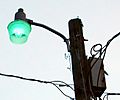Mercury-vapor lamp facts for kids
A mercury-vapor lamp is a special lamp. It makes light by a spark in a tube that contains mercury.
The spark makes the mercury atoms release ultraviolet and visible light. In some bulbs, the ultraviolet light shines on phosphors which make white light from it, although not all mercury-vapor lamps use phosphors.
The EU wants to ban them because they contain large amounts of mercury and are not efficient like fluorescent bulbs. They last much longer though. They are the bluish streetlights.
Depending on the quality of the bulb, age of the bulb, phosphor used, and other chemicals added to the mercury, the color of the light can vary from blue-white to green-white, to almost pure white. A green tint usually indicates an older bulb, although it doesn't necessarily mean that the bulb is about to burn out.
The metal halide lamp is an improved version of the mercury vapor lamp that contains a metal halide (usually sodium iodide) in addition to the mercury. The metal halide produces orange light, which combines with the blue-white light from the mercury to produce a very pure white light.
Related pages
Images for kids
-
A 175-watt mercury-vapor light approximately 15 seconds after starting.
-
A closeup of a 175-W mercury vapor lamp. The small diagonal cylinder at the bottom of the arc tube is a resistor which supplies current to the starter electrode.
See also
 In Spanish: Lámpara de vapor de mercurio para niños
In Spanish: Lámpara de vapor de mercurio para niños










